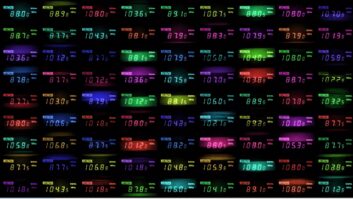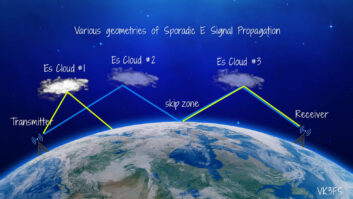This week we’re featuring highlights of Radio World’s 2021 ebooks.
The online WorldDAB Automotive 2021 Conference in June provided looks at various aspects of digital radio in the car environment. Here’s a sampling of presentations, all viewable on WorldDAB’s YouTube channel. This story originally appeared in the ebook “Trends in Digital Radio 2021.”
Extra displays
“Co-driver” displays — those targeting the front-seat passenger — are among “mega trends” dominating the European automotive industry. Another is Android Automotive.
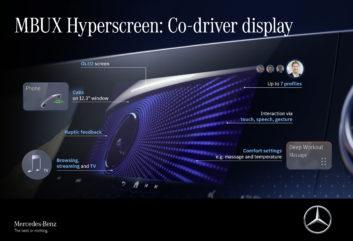
MBUX Hyperscreen: Co-driver display
Radio has to act fast to respond to both of these trends, said Martin Koch, head of development entertainment & car functions at Volkswagen CARIAD, during his talk “What’s Driving the Automotive Industry?”
He said such displays are turning up now in high-end cars, and their arrival is spurring a demand for high-quality visuals, which can include sophisticated slideshows, full-motion videos, games and multimedia tied to “browsing through the latest releases of your favorite artists,” he said.
Unfortunately, only about only 20 radio stations in the world currently support online slideshows, he said.
“This is not enough to really talk about providing a brilliant visual experience to drivers and co-drivers. So my recommendation for the broadcast industry is to make use of the technologies we already have in place and to develop concepts for attractive visual content to accompany their audio programming,” Koch said.
“And it’s not only the station logo or weather information: It can be so much more that attracts your customers and keeps them listening to your station and not switching to another media source or other content.”
Further, the presence of Android Automotive apps into the car will compete with DAB+ in the space and could undermine broadcast radio if these apps do not incorporate DAB+ features. Koch’s advice is for radio stations to build their own apps on the Android Automotive platform and “provide them, through the relevant app stores, to the dash of the car.”
Android Automotive
During the presentation “Global, Open and Available: A Broadcaster-Led Initiative for Radio on Android Automotive,” Joe D’Angelo, Xperi’s senior vice president of broadcast radio, asked Guru Nagarajan, Google’s engineering manager with Android Automotive OS, about the progress being made to bring that OS into the world’s cars, and about broadcast radio’s place in it.
“The first cars with the Android Automotive OS were launched this past year, and they were on Volvo Polestars,” Nagarajan said. “We’ve been very pleased with the user feedback and the feedback that we’re getting from our partners.”
Through efforts like the one led by NAB PILOT, radio broadcasters are working to be present in Android Automotive, in order to preserve their traditional prominence in car/truck entertainment systems. Fortunately, Google seems enthusiastic about radio’s place in this new app-driven environment.
“We continue to be very excited about broadcast radio,” said Nagarajan. “We think we can bring in a lot more capabilities for broadcasters and provide a platform that allows partners like Xperi and others to innovate and bring in the best from a user experience perspective.”
He added that Google is developing an Android Automotive application programming interface, or API, that will allow radio stations to localize their content on the app, and to generally enhance the platform to work better for broadcast radio.
“We would like to continue working with the broadcast ecosystem in both developing as well as innovating in the [Android Automotive] platform, and helping you all accelerate what you are really good at, which is providing the best of services to our users,” Nagarajan said.
France moves ahead
At present, about 30% of France’s population can receive DAB+ over the air. By the end of 2022, that should hit 50%, and roadway multiplexes will play a big part in helping them listen in the car.
These points were raised by Jean-Marc Dubreuil during his presentation “France: Automakers and Broadcasters’ Preparations for National DAB+.”
Dubreuil is WorldDAB’s manager for France and a member of the French joint broadcaster/vehicle manufacturer working group.
According to Dubreuil, 25 of France’s national radios services will be available in DAB+ on the country’s roadways by this fall. This is no small feat: “That means almost 12,000 kilometers of highways and a little more than 10,000 kilometers of main roads to cover,” he said. “It’s quite a lot.”
While this work is proceeding, challenges remain in coordinating the DAB+ rollout between broadcasters and car manufacturers. Specifically, carmakers and radios don’t necessarily understand their respective business model, said Dubreuil, nor the need to ensure that the in-car digital radios are kept up to date.
For instance, he said, “Radio stations were surprised not to see their logos on the dashboard of cars because the logos are sometimes burned into the receiver and often obsolete — because those radios were designed in 2014,” he said.
“Since then, life has moved on. The logo has changed.”
Meanwhile, the complexity of the French radio landscape, with its more than 1,000 FM stations and “a few hundreds of DAB+ services,” can make coordinating seamless coverage difficult. This is why it is important for all players in the French DAB+ ecosystem to work together, said Dubreuil.
Radioplayer hybrid app
WorldDAB has produced a set of User Experience guidelines for automotive manufacturers and broadcasters to help them offer provide the best digital radio interfaces for motorists.
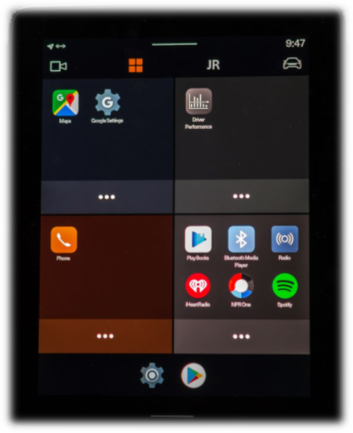
In the presentation “From Principle to Product: Bringing the WorldDAB UX Guidelines to Life in a Hybrid Radio App,” Radioplayer’s Caroline Grazé and Laurence Harrison described using these guidelines to guide the design and development of their hybrid radio app for the Android Automotive platform.
Grazé is managing director of Radioplayer Germany, Harrison is director of automotive partnerships at Radioplayer Worldwide.
“One of our main aims in building the app was to learn about Android Automotive and work with Google and others to improve the standard radio experience and make sure that it becomes hybrid,” said Harrison. When thinking about the user interface “the foundation of our design principles were taken from the WorldDAB UX guidelines.”
Ease of use is fundamental to the Radioplayer hybrid app design, Grazé said.
“The goal that is the most important one for the listener is ‘What am I listening to?’ I need to know. (And) I need to navigate simply through the UX.’” The app’s tuning database also has to be able to decode listener voice commands, including requests for stations that don’t use official call signs.
At an early stage in the user interface design, Radioplayer tested it on the road with consumers. By doing so, “you learn a huge amount about how intuitive the design is and also about the different positions of certain icons, and the features that people really value,” said Harrison.
The Radioplayer app now provides a “great hybrid radio experience,” he added, and “is being made available to car manufacturers to use on their Android Automotive platforms.”
Swiss DAB+ Retrofits
Switzerland’s plan to turn off FM by 2023 is driving DAB+ car radio retrofits, according to the presentation “Case Study: Switzerland, Getting Ready for FM Switchoff With the Auto Supply Chain.”
Speaking with host Ernst Werder of Weer GmbH, Jeremy Arztmann of Exclusive Car HiFi and Hans-Peter Saar of Robert Bosch AG described strong consumer demand for DAB+ adaptors to work with existing analog radios, as well as full DAB+ system replacements.
To ensure that Swiss motorists are satisfied with their DAB+ radio upgrades, Executive Car HiFi road-tests products before selling them to consumers.
“Since most larger auto importers are our customers, it’s usually very easy for us to get our hands on vehicles where we can test the products in order to ensure that the product is good and fine,” said Arztmann.
“Our company has been focusing on DAB+ for quite a long time, and we offer workshops with our partners so that all this technical know-how has grown continuously.”
Robert Bosch AG has been working with aftermarket partners such as Executive Car HiFi to meet the demand for DAB+ radio retrofits, said Hans-Peter Saar. In Switzerland, this market is geared towards higher-quality vehicles whose drivers don’t want to see adaptors and other devices detracting from original interior decors.
“The end user wants to use the OEM radio like he’s used to, and he wants his buttons on the steering wheel to work as he is used to,” said Saar. At the same time, they want to see song titles and other graphics, “on their regular radio screen and not on the small adaptor screen.”
Finally, some DAB+ equipment upgrades have been tailored for tasteful installations in older vehicles, including those that have achieved “vintage” status, built in 1991 or earlier.
“We have developed a solution where you can mount or install the DAB+ radio in a way that the vehicle doesn’t lose its vintage status or its historic status,” said Arztmann.
Localization and personalization
In the final WorldDAB Automotive 2021 presentation, “In-Vehicle Localization and Personalization: What They Mean for Radio Today and in the Future,” Swedish Radio Head of Digital Partnerships Tomas Granryd spoke with Francis Goffin, special adviser to the CEO of RTBF in Belgium, and Chris Ambrozic, TiVo’s VP of discovery, about using DAB+ to localize and personalize content to improve listener experiences, and to keep them listening longer.
In Belgium, RTBF, the country’s French-speaking public radio-TV broadcaster, is using DAB+’s localization capability to provide enhanced program choice to its VivaCité regional radio audiences.
For instance, this capability allows RTBF to provide seven different radio feeds, historically carried on seven separate FM stations, over four DAB+ regional multiplexes.
“Thanks to DAB+, listeners can choose to listen two different regional morning programs,” said Goffin. “This is impossible in FM, where they can only listen to the morning show that is available in their region.”
Localization is also allowing VivaCité to give listeners choices between live sports and non-sports programming over DAB+, which is not possible on FM.
RTBF and the private radio networks in the Belgian French-speaking digital radio alliance maRadio.be are looking at offering personalized radio programs to listeners using IP feeds triggered by inaudible tones in over-the-air DAB+ broadcasts. This platform could include “addressable radio advertising, just like the addressable TV advertising that started in Belgium last year,” Goffin said. It would do so using some kind of DAB+/IP hybrid platform that has yet to be developed by a new working group of RadioDNS, the hybrid radio open standard proponent.
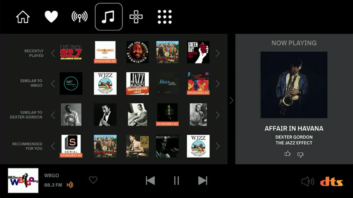
Picking up on the personalization thread, TiVo’s Chris Ambrozic spoke about applying the TiVo TV “carousel” model of program choice, using titled images of actual TV programs, to in-car DAB+ to boost listener engagement and loyalty.
“When personalization is utilized, we see very significant changes in viewer behavior,” Ambrozic said. “We see people watching about 25% more content on the video side. We see people churning away from their suppliers of content to the tune of about three times less.”
TiVo hopes to achieve the same results on DAB+ vehicle displays. “We’re taking that concept over into the car and to deliver a series of carousels, algorithmically driven with an understanding of what the person enjoys listening to,” he said.
A DAB+ content provider who takes this approach to in-car listening “is going to be able to monetize and deliver the right type of experience, not only from what to listen to, but also from an advertisement point of view.”


